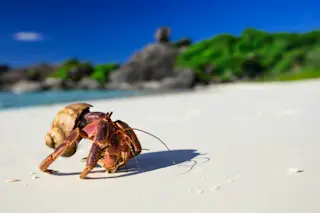Anyone with an older brother or sister knows that clothes “shopping” often meant begrudgingly sifting through hand-me-downs rather than perusing the latest fashions at the mall. But for hermit crabs, the hand-me-down system isn't second-best, it's a matter of life and death. And as a new clip from the BBC show Life Story shows, the swapping process is remarkably orderly.
Constantly Renovating
Hermit crabs need shells: without them, the critters will bake under the sun’s punishing rays, if they aren’t eaten first. The problem is hermit crabs are continually outgrowing their shells and the local real estate market is incredibly competitive. So when a spacious new shell washes up on shore, there’s a big to-do.
When a hermit crab spots a new shell, it’ll size up the shell for a good fit. If the shell is too big, the prospecting hermit crab will sit back and wait to steal the castoff shell of a larger crab that decides to upgrade. In the meantime, while the first crab waits, other crabs gather around the shell and do the same. When a crab large enough to fit the vacant shell arrives, a bit of orderly chaos ensues (video below).
The hermit crabs form a sort of conga line ordered from largest to smallest crab. As the largest crab enters its new home, the next crab in line takes the vacated shell, leaving an open shell for the crab behind him. The shell swapping continues down the line until everyone has upgraded. This chain reaction is called a vacancy chain, and it’s an ingenious way for the creatures to survive while sharing limited resources.
Tough Market
The housing market for hermit crabs isn’t going to get any less competitive if certain trends continue. Ocean acidification, an effect of rising atmospheric carbon dioxide, is changing pH levels of the tidal rock pools the crabs call home. Lower pH levels can make shells thinner and even seem to affect hermit crabs’ decision-making skills, making them discard suboptimal shells less readily.
For the most part, hermit crabs’ present hand-me-down system works, however — that is, unless you happen to be the runt at the end of the swap line ... Better luck next time lil guy.














